Chiara Quartet bids farewell with new Glass, classic artistry

The Chiara String Quartet performed Saturday at the Met Museum.
The final local concert from the Chiara String Quartet Saturday afternoon at the Metropolitan Museum of Art also brought something new–the New York premiere of Philip Glass’ Piano Quintet “Annunciation.” The concert also had a surprise—the liturgical Orthodox vocal sextet, the Axion Estin chanters. They were on hand to demonstrate some of the material at the core of Glass’s new composition, though it was impossible to discern the music they sang in the quintet.
This was the Chiara Quartet’s show though, and the group–which has been around for close to two decades–will be missed. In a contemporary musical landscape where there are excellent quartets in every direction, they have distinguished themselves with a warm, sweet, grainy sound. Beyond that, the group has made a specialty of playing certain repertory-like the Brahms and Bartok quartets-from memory.
This is not any kind of stunt, it’s a performance technique that adds an important quality to the interpretation and expression. As basic as it seems, removing the line-of-sight hindrance of music stands means the musicians’ interactions with each other are much more engaged.
The quartet played only one scheduled piece from memory, Beethoven’s Op. 132 Quartet in A minor. Fittingly, this was the valedictory, second-half work, though the musicians seemed to be playing it for themselves as much as the listeners in the seats.
The players spoke to each other palpably via their instruments, and so intimately that they might have been playing behind a one-way mirror. The interpretation was musical, weighted towards a legato flow rather than emphasizing syncopations and rhythmic accents. It also seemed full of secret signifiers. The holy prayer of thanksgiving was lovely but from the seats felt diffident. Extroversion finally came in an energetic finale. This was a downside of playing from memory, which sometimes produces a private performance in a public setting.
The first half was fully public, opening with Nico Muhly’s marvelous Diacritical Marks, Nos. 1-8. Muhly’s program note described the material as small and discrete technical gestures, but that in no way does justice to the sonic beauty and the keen, deep expression of these miniatures. The eight pithy sections use minimal means, the music ranging from agitation, hesitancy, dignity, and melancholic determination. Some phrases were at the precipice of sentimentality, but were reigned in by exquisite harmonies that pressed against the listener with a comforting weight.
Joined by pianist Paul Barnes, the musicians played Glass in between two performances by Axion Estin. The earthiness and sense of eternal time in these—styles from the 20th century that sound like that from the 18th-were a good contrast with the polished chamber music.
The Piano Quintet, completed just this year, was another piece in the fascinating mosaic of Glass’s late style. His music has increased in color and chromaticism, and gives the impression of the composer exploring his own favored memories of the classical repertory. Not only the format, but the warm inner expression seemed almost to echo Brahms, though Glass’s repetitive minimalism is a completely different style. Until, that is, the finale, a mischievous rising major scale that could have come directly from Brahms, Mozart, or Beethoven.
Called back for an encore,the Chiara played the Andantino from Debussy’s G minor Quartet. This was not only the finest moment of the concert, by an exponential margin, but the gentlest, most moving and breathtaking performance of the music imaginable.